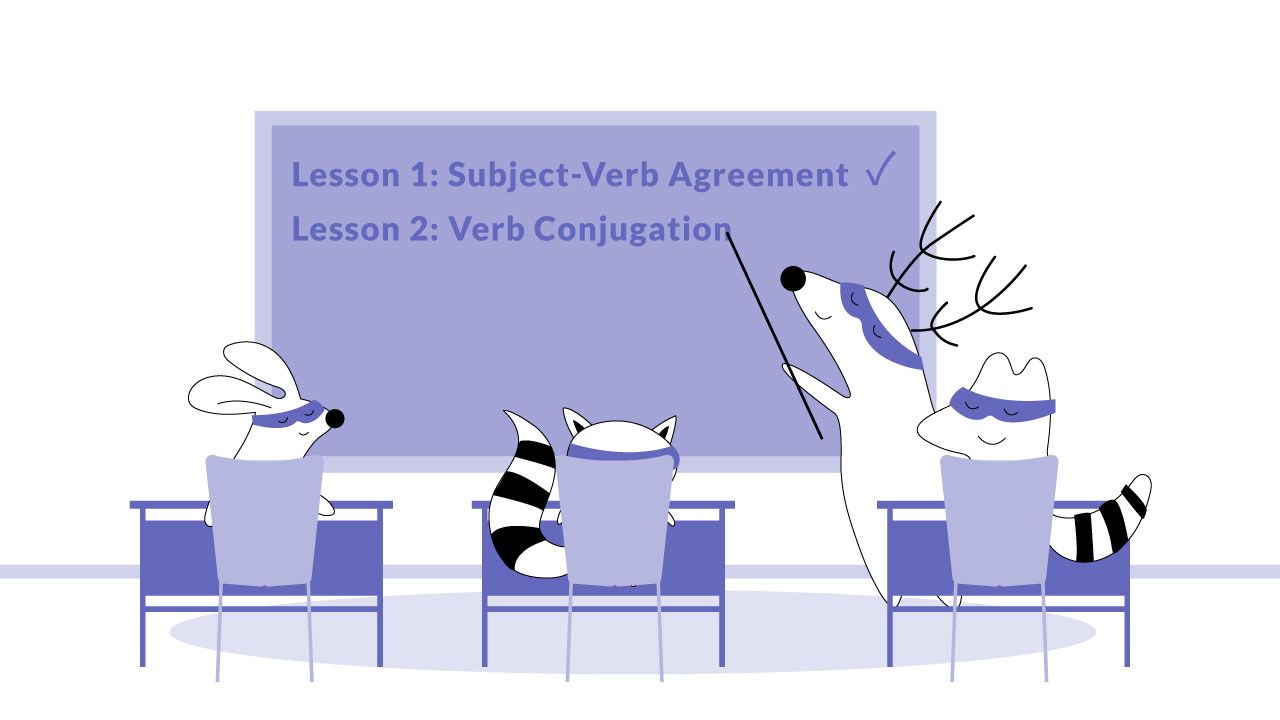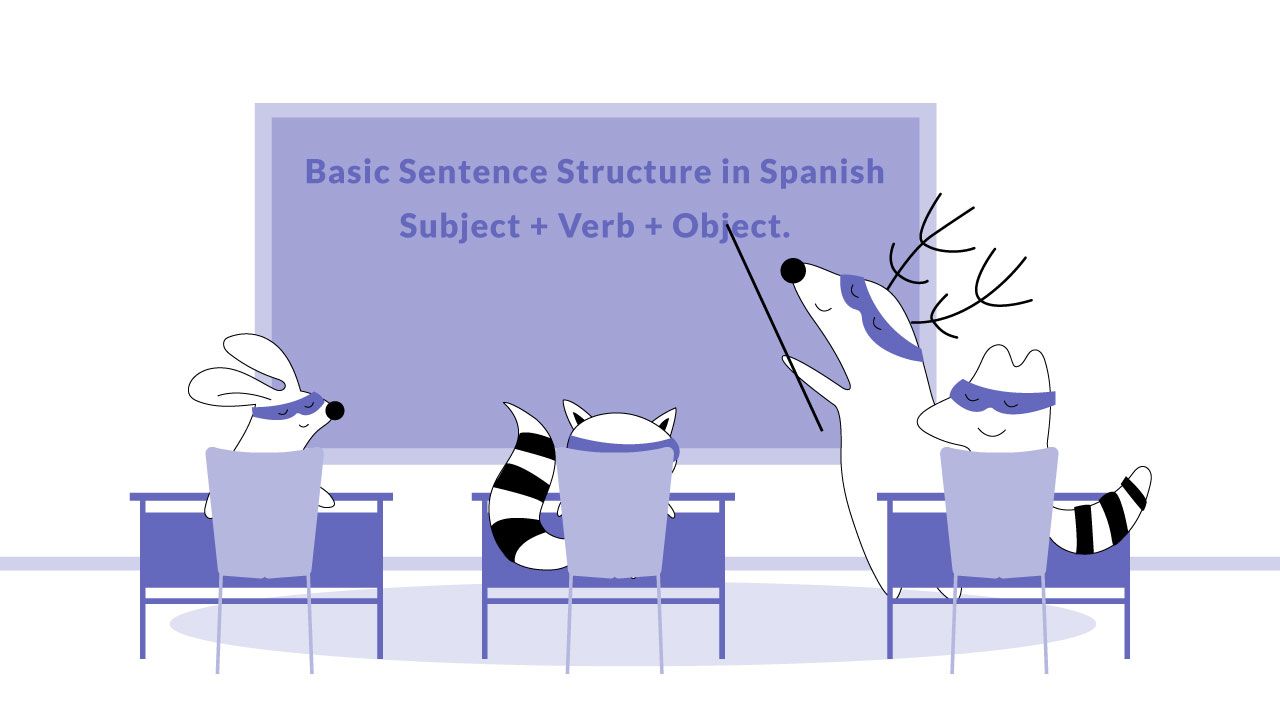
If you're new to Spanish, one of the very first things you need to learn is constructing basic Spanish sentences. In fact, it’s as essential as expanding your Spanish vocabulary. What’s the point in learning new Spanish words if you don’t know how to use them correctly?
For those learning Spanish as their second language, and especially native English speakers, Spanish sentence structure may seem confusing at first. However, with a little practice, it will become second nature.
This guide will introduce you to the basics of Spanish sentence structure, including subject-verb agreement, verb tense, and word order. By the end of this guide, you'll be able to construct basic Spanish sentences with ease!
Subject-Verb Agreement in Spanish Grammar
Much like English the subject and verb must agree in number (singular or plural). Unlike English, subjects and verbs must also agree in gender (masculine or feminine). This means that if the subject is plural, the verb must be plural; if the subject is feminine, the verb must be feminine; and so on. For example:
1. Singular subjects require singular verbs and plural subjects require plural verbs:
Native
Translation
El gato come la comida.
The cat eats the food.
Los gatos comen la comida.
The cats eat the food.
2. Feminine subjects require feminine verbs:
Native
Translation
La mesa está sucia.
The table is dirty.
Las mesas están sucias.
The tables are dirty.
When there is more than one subject, and those subjects are of different genders, the verb agrees with the gender of the subject closest to it:
Native
Translation
Los chicos y las chicas comen pizza.
The boys and the girls eat pizza.
In this sentence, even though there are both masculine and feminine subjects, the verb agrees with the gender of the subject closest to it, which is chicas.
When there are two subjects of the same gender, and those subjects are joined by a conjunction (a word that joins two things together; e.g., y, pero, o), the verb agrees with the first subject:
Native
Translation
Juan y Pedro comen pizza.
Juan and Pedro eat pizza.
In this sentence, even though there are two subjects, the verb agrees with the first subject, Juan.
Verb Conjugation
Spanish has two main types of verbs: regular and irregular. Regular verbs follow a predictable pattern when conjugated (changes that reflect different tenses), while irregular verbs do not.
To conjugate a regular verb in the present tense (the tense used to describe what is happening right now), you have to remove the ending of the verb (-ar, -er, or -ir) and add a new ending that corresponds to the subject.
For example, the regular verb comer (to eat) would be conjugated like this:
| Subject | Pronoun | Conjugation |
|---|---|---|
| Yo | I | como |
| Tú | You, informal singular | comas |
| Él/Ella/Usted | He/She/You, formal singular | comerá |
| Nosotros/Nosotras | We | comemos |
| Vosotros/Vosotras | You, informal plural | coméis |
| Ellos/Ellas/Ustedes | They/You, formal plural | comen |
As you can see from the chart above, Spanish verb conjugation in the present tense requires you to remove the ending of the verb (-ar, -er, or -ir) and choose a corresponding ending, considering the subject.
Irregular verbs, on the other hand, do not follow this pattern and you’ll have to memorize them. Here are a few examples of the most common irregular verbs in Spanish:
- ser (to be),
- tender (to have),
- it (to go),
- hacer (to do/make),
- ver (to see).

Basic Sentence Structures: Spanish Word Order
Much like English, the word order of a Spanish sentence is important in conveying its meaning. For example, the following two sentences have different meanings even though they share the same words:
Native
Translation
Juan come pizza.
Juan eats pizza.
Pizza come Juan.
Pizza eats Juan.
As you can see, the word order in Spanish isn’t flexible. Changing the placement of the subject of the sentence can change the meaning of a sentence. However, there are some basic rules that you can follow to make sure your sentences are understandable.
Here are the building blocks you need to understand basic Spanish sentence structures and stating forming simple sentences in Spanish:
Declarative Sentences
A declarative sentence is a sentence that makes a statement. Basic Spanish sentence structures typically follow this word order – the same as in English:
Subject + Verb + Object
Native
Translation
Juan come pizza.
Juan eats pizza.
In this sentence, Juan is the subject, come is the verb, and pizza is the direct object.
However, if you want to put an emphasis on a different part of your statement, you can switch this word order. Like this:
Verb + Subject + Object
Native
Translation
Vinieron amigos a mi fiesta.
Friends came to my party.
In this sentence, amigos is the subject, vinieron is the verb, and a mi fiesta is an object. In this case, the emphasis is placed on the fact that friends came to the party.
Negative Sentences
In contrast to an affirmative sentence, which affirms or agrees with something, a negative sentence denies or disagrees with something. In the Spanish language, negative sentences typically follow this word order:
Subject + No + Verb + Object
Native
Translation
Juan no come pizza.
Juan doesn't eat pizza.
In this sentence, the subject is Juan, the verb is come (eats), the direct object is pizza, and the word no (not) negates the verb.
Double Negation
Double negatives are two negative words used in the same sentence. In Spanish, double negatives are typically formed with the word no and a negative expression (frequently a pronoun) such as nadie (nobody), ninguno (none), or nunca (never).
Native
Translation
No me gusta nada.
I don’t like nothing. = I don’t like anything.
In this sentence, the word no (not) negates the verb gustar (to like), and the negative pronoun nada (anything) negates the noun me gusta (I like).
Double negatives are considered grammatically incorrect and may sound odd in English, but they are generally fine in basic Spanish sentences.

Interrogative Sentences
To turn declarative sentences into questions in the Spanish language, all you have to do is switch verb and subject in their positions:
Subject + Verb + Object → Verb + Subject + Object
| Juan come pizza. | Juan eats pizza. | A declarative sentence. |
| ¿Come Juan pizza? | Does Juan eat pizza? | An interrogative sentence. |
It's important to note that Spanish questions typically end with a question mark at the beginning and the end of a question (¿?), while English questions typically end with just a question mark at the end of the interrogative sentence (?).
However, there is another, simpler way to form a question in Spanish grammar. In yes or no questions, you can just add question marks at the beginning and at the end of the affirmative sentence and use rising intonation towards the end of a question.
Nothing in the sentence structure changes, yet it stays grammatically correct. Like this:
| Vamos al cine. | We’re going to the cinema. | An affirmative sentence. |
| ¿Vamos al cine? | Are we going to the cinema? | An interrogative sentence. |
Question Words
Question words are words that are used to ask a question. In Spanish, some of the most common question words include quién (who), cuál (which), dónde (where), cómo (how), and por qué (why).
To form a question in Spanish, simply begin your sentence with the question word and add question marks. For example:
Native
Translation
¿Dónde está Juan?
Where is Juan?
¿Cuál es tu nombre?
What is your name?
Adjective Placement in Spanish Grammar
In a basic Spanish sentence structure, Spanish adjectives typically go after the noun they modify. For example:
Native
Translation
Juan es un estudiante inteligent.
Juan is a smart student.
In this sentence, the subject is Juan, the verb is es (is), and the adjective intelligent (smart) modifies the noun estudiante (student).
However, there are some exceptions to this rule:
1. When an adjective describes the physical characteristics of a person or thing, it typically goes before the noun it modifies. For example:
Native
Translation
Es un hombre grande.
He's a tall man.
In this sentence, the subject is un hombre (a man), the verb is es (is), and the adjective grande (tall) modifies the noun hombre (man).
2. When an adjective describes the quantity of a noun, it typically goes before the noun it modifies. Like this:
Native
Translation
Tengo muchos libros.
I have many books.
In this sentence, the subject is Tengo (I have), the verb is tengo (have), and the adjective muchos (many) modifies the noun libros (books).
3. When an adjective is related to the opinion of the speaker about a noun, it typically goes before the noun it modifies. For example:
Native
Translation
Me gusta el buen vino.
I like good wine.
In this sentence, the subject is Me (I), the verb is gusta (like), and the adjective buen (good) modifies the noun vino (wine).
When two or more adjectives describe a noun, we typically place adjectives in the following order:
Quantity → Opinion → Size/Shape → Age/Color/Origin
Native
Translation
Tengo un libro viejo pequeño.
I have a small old book.
In this sentence, the subject is Tengo (I have), the verb is tengo (have), and the adjectives viejo (old) and pequeño (small) modify the noun libro (book).
As you can see from the example above, the position of adjectives can be different in other languages, so it's important to remember the correct order when you form sentences in Spanish. While this might seem very complex, English follows a similar pattern for order of adjectives.

Adverb Placement in Spanish Grammar
Most of the time, you'll place adverbs after the verb in Spanish. This can be a bit confusing for English speakers, who are used to placing adverbs before the verb. For example, take a look at the following sentence:
Native
Translation
Necesito hablar más despacio.
I need to speak more slowly.
In this sentence, the adverb despacio (slowly) comes after the verb hablar. This is because in Spanish, adverbs of manner (adverbios de modo) usually go after the verb. Adverbs of manner describe how something is done.
When it comes to adverbs that modify adjectives, they usually go after the adjective. For example:
Native
Translation
Es un niño muy inteligente.
He's a very smart boy.
In this sentence, the adverb muy (very) modifies the adjective intelligent (smart), so it comes after the adjective.
There are a few exceptions to this rule:
1. When the verb is conjugated in the third person singular or plural form. In these cases, the adverb usually goes before the verb. For example:
Native
Translation
Él siempre canta en la ducha.
He always sings in the shower.
In this sentence, the adverb siempre (always) goes before the verb canta because the verb is conjugated in the third person singular form.
2. When two verbs are used together. In these cases, the adverb usually goes between the two verbs. For example:
Native
Translation
Tenemos que empezar a estudiar más.
We have to start studying more.
In this sentence, the adverb más (more) goes between the verbs tenemos queue (we have to) and empezar (to start).
3. Adverbs that express frequency (adverbios de frecuencia), such as nunca (never) and siempre (always), usually go before the verb:
Native
Translation
Siempre voy en bicicleta al trabajo.
I always ride my bike to work.
In this sentence, the adverb siempre (always) goes before the verb voy.
The Bottom Line

We hope this article has helped you understand the basics of Spanish sentence structure. We’ve addressed subject-verb agreement, verb tense, and word order in Spanish. We also provided some examples of how these concepts work in practice. By understanding these concepts, you'll be able to construct basic Spanish sentences with ease!
Now that you know the basics of Spanish sentence structure, it's time to put your knowledge into practice! Download our Langster app to get even more grammar explanations and learn Spanish with stories. Good luck!








